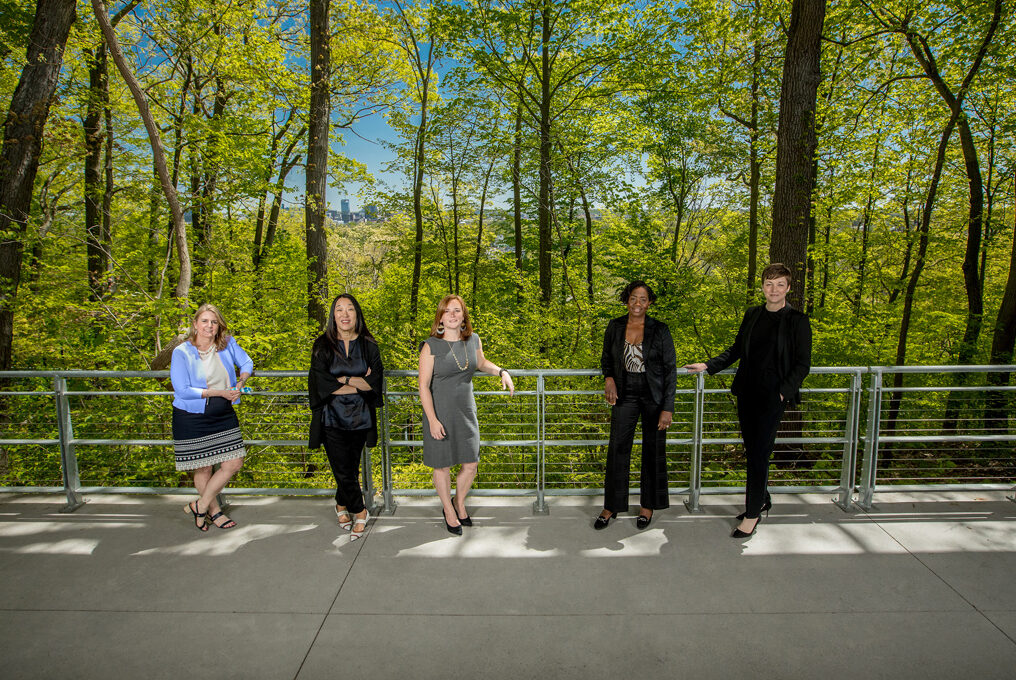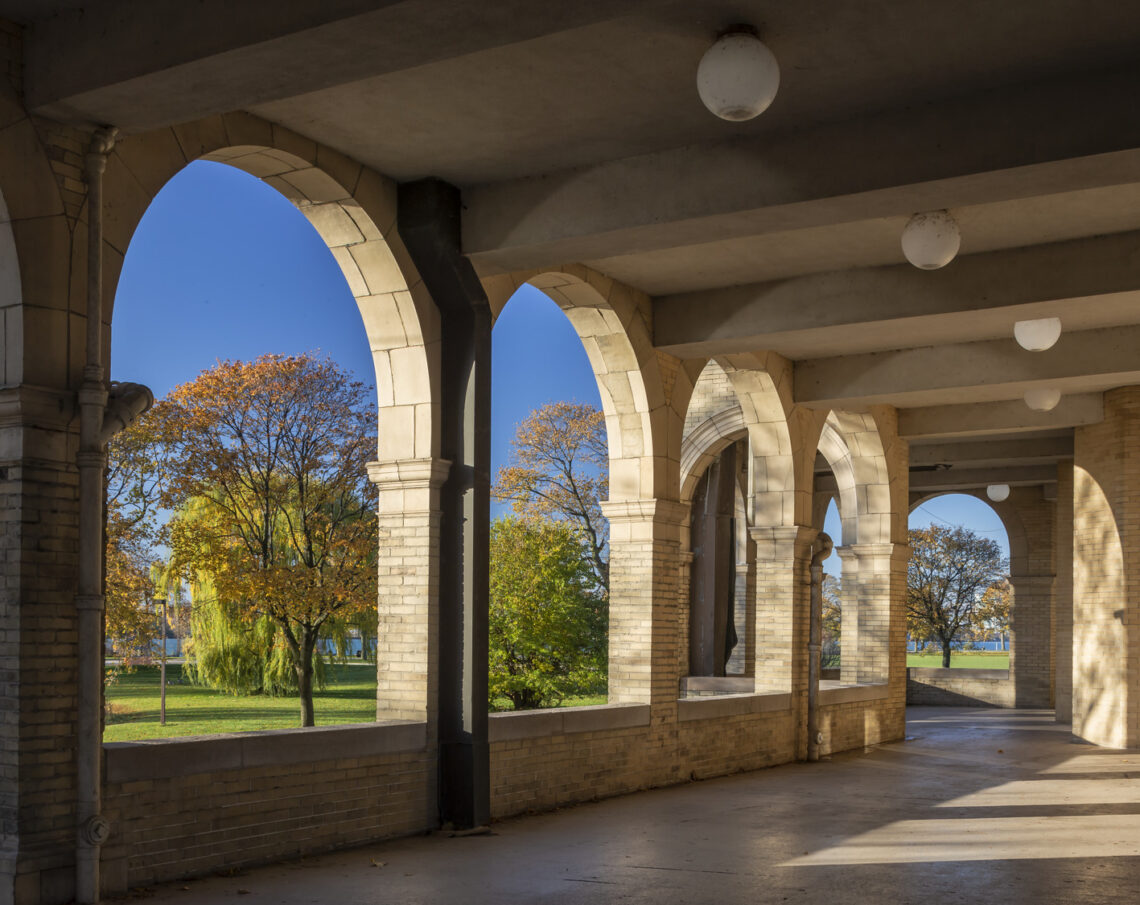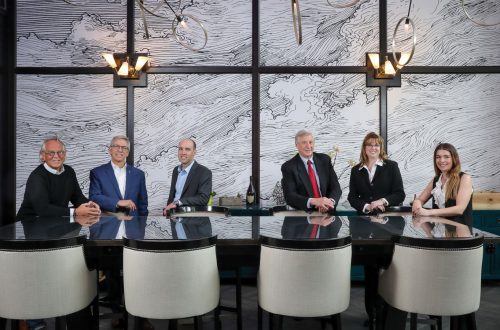Senior Architect
Quinn Evans | Ann Arbor, Michigan
Stories are often a powerful tool and intangible link of past, present, and future. They speak to the collective cultural memory as well as the personal, and the preservation of which can often leave an influential echo in the minds of those who come long after they have been written. In architecture, stories and narratives can be found in each building and every space within the built and natural landscape in an often visual and tactile form—or in the intentional use of the abstract space; from architectural vernacular, exterior stylistic dialect, and interior design language, to its surrounding context, and the very soil beneath their foundations.
To Kemba Braynon, AIA, NOMA, senior architect at Quinn Evans in Ann Arbor, Michigan and Chair of the Michigan State Historic Preservation Review Board, there is something special about the story behind a building, and it was her love of the written language that led her down a path to historic preservation as an architect.
“From an early age, I was interested in poetry and storytelling as forms of self-expression and considered becoming a writer. After high school, I took a gap year and did volunteer work in southern Africa. It was fascinating to see how factors such as culture and climate impact how people live and communities thrive, and it taught me a valuable lesson about the commonality of the human experience. I kept a journal during my year abroad, and in my early 20s, I was able to publish it as a travel memoir. I always meant to get back to writing, but decided to pursue architecture as a way of supporting myself,” Braynon said.
“During the Great Recession, the construction industry was hit particularly hard and many architects had to find work in unrelated fields. Because of my background as a writer and architect, I was able to find a job in Michigan with the City of Detroit writing and administering grants for historic preservation projects. That was my entry into the field of historic preservation and the first time I was able to use my skills as a writer to tell the story of buildings and why they needed to be saved and restored,” Braynon added.
Informed by an academic background and professional experience in both the creative and technical fields, Braynon has spent her career dedicated to ensuring historic buildings and sites survive for the future—and preserving their stories. Initially attending the University of Michigan in Ann Arbor to study English Literature, Braynon decided to also pursue a degree in architecture due to her additional love of science and physics.
“My mother was a professor of urban planning and had a love for cities. As a child, we visited regional centers and cities around the country and my mother always took the time to explain what made cities and communities great; everything from design to planning, to community hubs and downtowns. My father was a history professor and taught me the importance of storytelling. I grew up in a college town, and my middle school and high school had architecture and drafting classes. I enjoyed taking all of these classes as well as physics and math, which I really excelled at,” Braynon said. “When it came time to attend college and select a major, I ended up double majoring in both Architecture and English Literature. But I was still unsure as to how to forge a career out of both of them.”

Braynon received a Master of Architecture from the University of Michigan and spent roughly a decade in Chicago at a number of firms as an architect and project architect on a number of different typologies. Braynon noted it was the recession of 2008 that ultimately led her back to Michigan to apply her creative and technical expertise as a historic architect and planner with the City of Detroit. In her role as grant writer and project manager for nearly five years, Braynon coordinated efforts to preserve and rehabilitate historic buildings while navigating the Certified Local Government Historic Preservation Grant process; as well as work with local historic district designations like the James and Grace Lee Boggs Historic District, Franklin Wright Settlements Historic District, and Masjid Wali Muhammad/Temple No. 1 Historic District.
“I worked with other architects to restore buildings in Detroit including the Albert Khan-designed Belle Isle Aquarium, the Ford Piquette Plant Museum, and the Carillon Tower. It was a good experience to learn about the inner workings of city government and how to get things done. My last major project while on staff with the City of Detroit was a conditions assessment for the Belle Isle Carillon Tower,” Braynon said. “Quinn Evans was the architecture firm selected to perform the assessment. As grant writer and administrator for the project, I worked closely with Quinn Evans as they collected historic documentation and drafted the report.”
Braynon also noted it was about that time when her mother sat her down and had a “heart-to-heart” about whether she wanted to return to the private sector side of architecture, having been within government for a number of years.
“It felt like a long shot, but I reached out to the Quinn Evans architect who was working with me on the Carillon and asked, ‘if you’re ever planning on hiring more architects, just let me know. I’m looking to get back into the profession.’ The next day I received a call from one of the principals at Quinn Evans inviting me in for an interview,” Braynon said.
“That was how I ended up back in the private sector as a historic preservation architect with Quinn Evans. My background in preservation isn’t from a university program such as Eastern Michigan’s preservation program; it’s from being on the ground working with communities, city governments, historic preservation agencies such as MSHDA/SHPO to help restore historic buildings in Detroit,” Braynon added.
Quinn Evans is a full-service architecture and planning firm with a mission to craft solutions connecting people to community and history to future. Since its establishment in 1984, Quinn Evans has become known for its historic preservation and renovation work as it applies context-sensitive and innovative design solutions from across its network of office locations such as in Washington D.C.; Ann Arbor; and Detroit; among others. In April 2022, the firm will also be women-owned. As Senior Architect, Braynon works with institutional clients like the Department of Natural Resources and Amtrack, restoring numerous historic train stations across the country like the 30th Street Station in Philadelphia, and Niles Station and Jackson Station in Michigan. Braynon is also currently working on a museum and educational facility at a national historic civil rights site.
“We’re currently in the early design phases of the project, which will eventually include the adaptive reuse of several former commercial buildings. One of the highlights of the project was a series of interviews with community members, including those who were school children during the Civil Rights movement,” Braynon said.
“Their stories reflected the commitment of everyday people to defend the right to justice and opportunity for all Americans, especially African Americans. It’s exciting to find ways to express this architecturally, and to honor their legacy,” Braynon added.
Since foraying into the field, Braynon noted she has found the project management side of work at the “30,000-feet-level” really exciting and being able to collaborate with both clients and communities to shepherd projects from start to finish. It is also the relationships built and the idea of honoring legacies—translating that into the built environment—that inspires Braynon to work closely with clients, user groups, and stakeholders to ensure vision and scope to help articulate and explore solutions to ultimately exceed expectations, such as when working with a client on the west coast to recreate overall goals and vision for a lounge space after an initial site visit.
“It started as a small project back in 2017 and at first the client just wanted us to design a very small lounge in an existing transportation hub,’” Braynon said. “We ended up doing some preliminary back-of-napkin sketches and they ended up getting the funding to actually realize that sort of wish-list dream. It’s about listening and being open to what the client may not have initially articulated and then relaying it back to them to see if it is something we should explore. It’s about dreaming alongside them.”
Outside of her work at Quinn Evans, Braynon was also recently designated in February 2021 as Chair of the Michigan State Historic Preservation Review Board, which she has been involved in since her initial appointment in 2015. For Braynon, who said she has always loved old buildings and found them special, unique, and worth saving, one of the exciting developments at the Michigan State Historic Preservation Review Board is the consideration of Civil Rights sites.
“In the years that I’ve been a historic preservationist, the field has evolved to include stories that reflect the country’s complicated history and rich cultural diversity. And this includes the recognition that buildings and sites reflecting the Civil Rights movement should be honored and preserved. A few years ago, I was on the State Historic Preservation Review Board when we reviewed a National Register nomination entitled: Twentieth Century Civil Rights Sites in the City of Detroit. This particular nomination was so exciting, because it documented the history and typology of buildings, districts, and sites related to the African American civil rights struggle in the city of Detroit. It touched on several themes including the role of Detroit’s black churches in the Civil Rights movement, the demand for fair housing in Detroit, black-owned businesses and the automobile industry,” Braynon said.
“This nomination really helped open the door to looking at historic sites in Detroit that were important to the Civil Rights movement and that may not have the level of physical integrity that people think of being worthy of preserving, but having that social history that makes them worth preserving and honoring,” Braynon added.
For Braynon, the importance of inclusion is an issue architecture as a whole is facing and while the community is becoming more diverse—not just racially, but also in terms of orientation and ability—there is still a need for architects to be sensitive to that and who reflect the diversity found in communities. It was partly why she wanted to be a part of the National Organization of Minority Architects, which she recently completed a two-year term as President of the Detroit Chapter, especially after being met with discouragement when first expressing an interest in architecture as an undergraduate.
“It made me even more determined to apply and I was able to get in and do well, but I realized that I wasn’t the first young Black woman to be discouraged to go into the field and I wouldn’t be the last and there had to be a way to help encourage and nurture people on the journey of becoming an architect,” Braynon said.
It was also important to show young Black women, including her own daughter, that the path of architecture is open to them, as well as finding ways to encourage and support young minority architects of all different communities so they don’t feel as isolated. Braynon noted it is no longer acceptable that most architects are white males when designing for an environment that is so diverse and varied.
“I think it is a little similar for women. There are a lot of women who start the program, but as we advance in the profession, we tend to fall out. I’d say another thing is just creating a culture that is supportive of women and by extension families, because one of the reasons we fall out is that there is a work ethic in the field that is inhospitable to moms,” Braynon said. “But there are firms making a difference, such as Quinn Evans. We have a work environment that is supportive of flexibility, part-time, and work-life balance, which is rare. I think more architecture firms need to be in line with those principles to encourage retention with women. I’m so glad to have landed here.”
For those interested in the field, Braynon said the advice she would give is that architecture is a really vast field encompassing a lot of roles. While in the program, Braynon noted she was trained to think everyone is going to be the designer, but as she got into the field, she realized there are so many exciting parts to make a project happen other than the design itself.
“It might take a while to find your footing and to find out where that spark is for you, but just hold the course. It took me 10 years of thinking ‘why did I choose this field?’ until I landed in that small government office in Detroit and discovered that I really like preservation and I like project management. That was really the spark for me,” Braynon said. “Be open to different avenues and different things that you can do with your degree and the different places it might take you, because projects are created by teams and there are many different roles to play in that team.”
To Braynon, design is a beautiful means of finding a way to meet form with function, it shouldn’t be just design for design’s sake, and for her, the vision of architecture and design’s future looks like community.
“I’d love to see more community engagement and involvement with the design process and with buildings, so that it is not just a small, elite group of architects who are coming up with designs in isolation, but they are really working with communities and users to help define the space and to see what it is that they really need to thrive and to flourish,” Braynon said.
First published in Great Lakes By Design: Architectonics, 2021
Text: R.J. Weick
Photography: (profile) M-Buck Studio LLC
Selected projects:
2021 Architects







